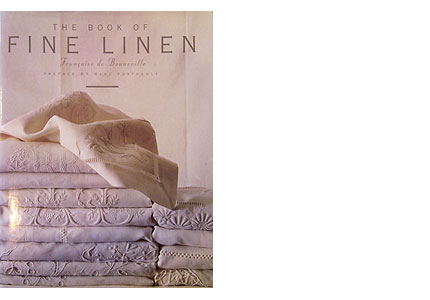

The sensuous joys of fine linens for the home are celebrated in this beautifully illustrated book. Written by Francoise de Bonneville and translated from the French by Deke Dusinberre, The Book of Fine Linen draws upon contemporary literature, letters, and diaries to convey the plenitude linens represented in centuries past, in modest and affluent households alike. Along with many photographs, the reader sees evolving trends in linen use as shown in advertising and fine art. Examples from museums and private collections reveal the magnificent craftsmanship evidenced in specially woven, hand-sewn, lavishly decorated bed sheets, towels, and tablecloths. In describing the emergence of new technologies in weaving and printing, Bonneville brings the reader to a new understanding of the designer’s art.
The trousseau, stacks of sheets, towels, tablecloths, and other items housed in an armoire, was a measure of a bride’s wealth and in many cases reflected years of needlework on her part. The linen cupboard could become a kind of memory box, storing items handed down from her foremothers, and provide a hiding place for letters and other small treasures. Bonneville describes prodigious hoards assembled for royal weddings, and estate inventories that enumerate what remained after a lifetime of wear, house fires, thefts, and other losses. Changes in customs affected such matters as displays of the trousseau during the wedding period, who ought to embroider the monograms, and, later, which department stores were in keeping with a family’s social position.
The “art” of laundry is examined in a chapter titled, “Soap Opera,” and includes a detail from Bruegel’s Flemish Market and Washhouse, showing all manner of whites spread across a broad, green lawn to be bleached by the sun. Here we learn of the physically exhausting washing methods of the past, and the reading is enough to make one feel lightheaded. Elaborate traditions should naturally surround anything that consumes so much time and energy, and such details as when, where, and with whom one washed the household linens were a matter for extensive comment, of which the author here shares many instances. Well aware of the value of such information, washerwomen were privy to many of their clients’ secrets as evidenced by the stains their linens carried.
In “The Thread of the Tale,” Bonneville gives a frank and intimate look at the use of linens through human history. As elsewhere in the book, records of the demands made by royalty through the centuries are quoted at length. Among the topics covered are ceremonial use of linens, the politics of lace, and the advent of designer sheets and towels. The reader will recognize the effects of linen handling procedures in the details of famous paintings.
The term “linen” has broadened in its meaning, from the literal to the generic, as new fibers have been employed in manufacturing cloth. The chapter titled simply, “Cotton, Linen and Silk,” gives us a technical yet entertaining look at the natural, agricultural, and industrial processes that bring household linens into being. As with many ventures, success led to wealth, exploitation, and conquest, and the drama is entwined with the history of nations.
Lastly Bonneville introduces us to the wonders of ornamentation, and her chapter on the subject brings us forward into the present day. The decoration of household linens, though impressive in its past manifestations, are shown here to be enjoying a golden age in our time, with the vast array of tools and technology at the designer’s disposal.
This panoramic view of the subject is presented with a distinctly French perspective and panache. The Book of Fine Linen makes a splendid gift for a bride, or anyone with sophisticated domestic tastes.
Return to Home by Design